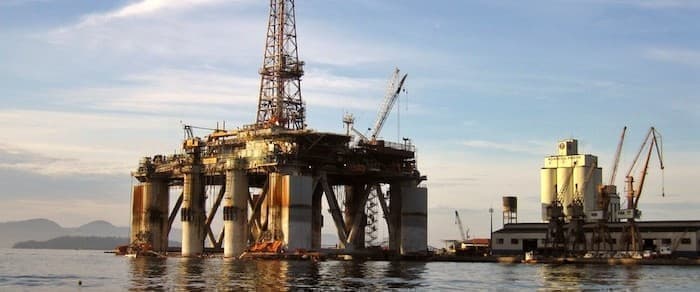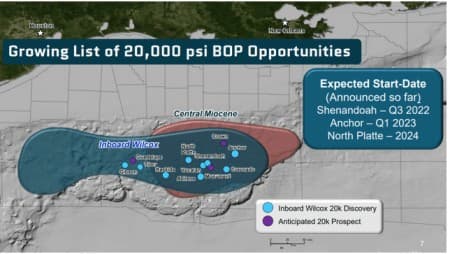The Dawn Of A New Era In Deepwater Drilling

A new era in deepwater drilling is about to begin. With the sanctioning of the Anchor project super-major operator, Chevron, NYSE: CVX) signaled that it was ready to risk billions tapping the ultra-high pressure, Lower Wilcox Tertiary play, some 35,000 feet below the mudline. At least two other projects are in advanced FID status with several more under review. In this article we will look at some of the key players in this “final frontier” for the Gulf of Mexico, and why they are gearing up to exploit this remote reservoir. We will also look at one we feel is particularly poised to reap the bulk of this activity and the profits that will come from it.
One of the biggest deepwater drillers, Transocean, (NYSE:RIG) notes in an investor packet that in the next few years a number of opportunities could be spun from the success of the Anchor (sanctioned) project and the North Platte and Shenandoah projects (nearing sanction).
RIG sees a healthy candidate pool for its unique 20K psi BOP drillships, the Deepwater Atlas and the Deepwater Titan. These are the only two rigs with this rating, and probably the only two of these billion-dollar babies that will be built from scratch.
Valaris, (NYSE:VAL) announced in its quarterly conference call that its 7th generation drillship, the DS-11 will be restored from “preservation stack”, and kitted out with a 20K psi BOP. This rig, when properly configured, will be used to drill the North Platte project for Total Energies, (NYSE:TTE), with a 2024 start date. VAL will receive upfront payments for the upgrade and those costs are not included in the $1.3 bn increase in backlog from Q-1.
With only three of these high-specification rigs being planned, compensation should be well above the average ~$225K per day most of the still-active 7th generation drillships are receiving. Here’s what we know.
The value of the Anchor contract is $830 mm and over the 5-year life of the contract amounts to $455 per day. A fairly skinny deal when you factor in the additional capex for the 20K BOP stack and ancillary equipment. It was struck a couple of years ago, in the heart of the downturn. I think future contracts will improve markedly on the announced contract value for Chevron (CVX).
As an indication of progress, we can take the estimated $490K day rate for the Deepwater Atlas for Beacon Offshore's Shenandoah project. A 4-well deal that was pending sanction news by the end of July. Crickets so far.
There is also some discussion about the fact that the end of July came and went without a sanctioning announcement for Shenandoah. I don't have a seat in the boardroom at Beacon, but I can tell you that this is the hottest thing they have going. If they don't develop this massive, 1,000' net pay, light oil interval, with subsea export for the oil to any number of nearby hosts - Jack, Kaskida, St. Malo, Cascade among them, and export of the gas to the Discovery gas plant in Louisiana, I would have to question their raison d'etre.
A brain-child of Blackstone Energy Partners, Beacon was formed in 2016 for the express purpose of developing high-quality oil reservoirs in the GoM. Beacon owns interests in a number of ongoing and pre-FID projects that include Blue Wing, Olive, Buckskin, Claiborne, Crown & Anchor, La Femme, McKinney, Moccasin, Praline, Red Zinger, Shenandoah, Stonefly, and Yucatan. Many of these are just a hop, skip, and a jump from Shenandoah. There is little doubt in my mind that Shenandoah goes forward.
As to North Platte, my expectation is the day rate for the DS-11 will amount to about half the value of the contract awards VAL announced. With a 1,277 day term, that would work out to ~$470K per day. Quite a bit better than RIG’s deal for Anchor, particularly when you take into account, RIG had to shoulder the cost for the 20K BOP stack. It should also be noted that the start date in 2024 is far enough away that it’s unlikely VAL gave it away cheaply. Thomas Burke, CEO of Valaris commented in the Q-2 analyst call-
“U.S. Gulf operators have expedited drillship selections this year in anticipation of a lack of supply in early 2022, which has played a key role in pushing day rates in this market higher.”
We will circle back to provide some analysis of this improvement in the state-of-play for the deepwater drillers as we close out this article. For now, let’s dive into what is driving this ground breaking push into the Lower Wilcox.
What’s special about the Lower Wilcox Tertiary play?
The GoM is a unique area with broad areas of sediment burial depths up to 30-35K feet below the mudline in water depths of 6-7000 feet, generating these incredible pressures. You find this exact scenario only sporadically in other areas of the world.
As noted above the Lower Tertiary Wilcox turbidite sands are the principal target in these projects. This is a resource that has a hundred-year history of providing oil and gas in generous quantities. The oil industry knows it well. The onshore Wilcox trend is estimated to have provided ~24 TCF of gas in that time.
As Meyer et al, noted in a comprehensive World Oil article in 2005, it took some imagination to think the Wilcox petroleum systems existed ~250 miles offshore in the ultra deepwaters of the GoM. The BAHA #2 first demonstrated its existence in 2001, and later Great White set the western boundary and Cascade set the eastern boundary. A contiguous field spanning some 350 miles in length and 150 miles in breadth, where infill discoveries over the last 20 years have found ~15 bn barrels of oil, with an estimated equal amount remaining to be discovered and produced.
The thing that draws the drill bit in the deepwater Lower Wilcox is the high flow characteristics of the reservoir, as noted by Dice. Comprised of a well-sorted, quartz-rich sandstone with porosity in the 20-25% range, and permeability averaging 10 mD across the play, in comparison to the Upper Wilcox, the Lower Wilcox exhibits a...
...stronger pore-level framework and resistance to compaction and porosity reduction.
The final carrot is the oil quality from the Lower Wilcox, ranging between 28 and 38 gravity and produced from thickness accumulations running into the hundreds of feet of vertical depth.
You will note in the table above that a number of the producing Wilcox projects are almost a decade old. Their rates are falling and either they will soon enter terminal declines where it is no longer economic to produce them or be put on water/polymer flood. What is certain that as 90+% off offshore production (~1.8 MM BOPED) comes from deepwater projects, these projects must be replaced and the Lower Wilcox is about the last place left for major finds in the GoM. Unless of course we were able to tap the Eastern GoM, but that's been off-limits to development for decades. A scenario that’s unlikely to change anytime soon.
Finally, one of the things that makes the GoM so attractive is the huge installed equipment base. With 25 years of deepwater activity behind us in the U.S. GoM, the infrastructure advantages many of the projects we have discussed with export options already in place. Hundreds of billions of dollars-worth of facilities are in a state of declining use as older wells peter out. All of the projects we’ve discussed in this article are made possible in-part by not having to FID long undersea pipelines or massive host platforms.
Your takeaway
The GoM has been for decades a reliable source of oil and gas, and with success in this new Lower Wilcox play, this productivity may be extended for several more.
There has been a substantial sell-off in energy-related equities in the last few weeks. RIG which in early July, was selling at $5.13 per share, means in retrospect there was a lot of optimism priced into the stock. At ~$3.50 the reverse is true.
I discussed some likely outcomes for oil in a recent OilPrice article. Nothing has really changed other than the market's short term sentiment. As noted in the linked article, this is largely due to OPEC+ spat - which is being worked out - and concerns about the Delta variant slowing the economic recovery. Inflation jitters aren't helping anything either. Inflation is a tax on growth, and there could be some headed our way - you don't print ten-trillion dollars in six months without debasing the currency to some extent. My view is the worst fears are overstated and the amazing American economy will pull us out of prolonged period of inflation.
RIG is trading right about 3.5X their 2020 OCF of ~$600 mm on an annualized basis. A week ago that factor was almost 5X. If you buy my argument that their utilization and day rates will improve modestly in 2022 their cash from operations could at least double by year-end '22. This is a bullish view that actually exceeds RIG’s own forecast of ~$962 mm through YE 2022. If these numbers are attained on the back of improved day rates the stock should get into the $7-10.0 range and justify the risk.
As always we should add that the deepwater drillers are among the riskiest of investments with capital appreciation at the start of a new cycle being the only reason to invest. That said the dark days of the past six-years appear to be fading, and some new optimism provides a reasonable investment case for risk-tolerant investors.






